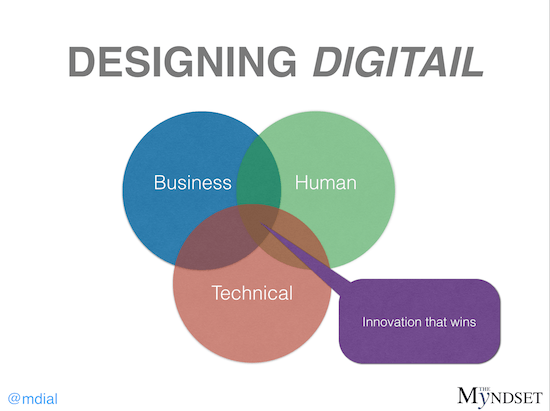Most serious retailers are now looking deeply at ways to go “digitail” aka exploit digital in retail. In other words, they are looking for ways to use and ‘manage’ digital tools, devices and platforms in the retail space for good business effect. To the surprise of many companies, the transformation required for digitail is not anecdotal. Digital is a strategic consideration because it involves three vital components of brand building:
- Communications. Digital now plays an integral role in communicating with the customer and building a relationship. After all, relationships are based on communication. {Tweet this!}
- Data. Call it big, small or intelligent data, but brands who understand their customer base and have earned the trust to gain the customer’s data, have a significant foot up.
- Loyalty. Customer Relationship Management (CRM) is fundamentally about creating loyalty. However, a loyalty programme without the purchase information is nothing.{Tweet this!} Digital is creating many new ways to establish a relationship, to foster trust and to collect payment.
But, where to start? And what skillsets are needed to implement “digitail” (digital in retail) effectively?
Start with the objectives in mind
There are many digital options for a retailer to consider. And, the challenge is far from a technical challenge only. The process requires marrying the business objectives and business model (ROI) with the human interactions (store personnel and customers), and finding a technological solution to satisfy these criteria.
Once you have established clear objectives for the digitail initiative, there are three important ingredients that a marketer should bring to the table in crafting a digitail strategy.
- First, make sure the right team is in place. Having the right technical partner and/or agency will be fundamental. This means synchronizing, in particular, with the store staff, IT and customer service. Providing the right support and training for the instore staff is also essential.
- Secondly, the C-suite and brand marketer must have an obsession with the customer experience. What is the customer journey? Is the UX well done? What role should the store staff have? How will the experience be evaluated and measured? For this, it would be highly recommendable for the person(s) responsible for the project to spend a considerable amount of time observing customers and staff in the store. Importantly, is there data to support any insights?
- Thirdly, it is important to consider the duration of the program. Not all initiatives need to be long-term. However, it is vital to consider in advance the end game and/or next steps, according the initiative at hand. This means budgeting the necessary resources for v2, the next generation or the next promotion, etc. The more forward thinking can be done, the more chances the (bespoke) technology will be appropriately scaled to cater to new programs down the road.
Contingency planning is essential
Also, since the technology is typically new, it is essential to have a back-up plan for when (not if) it bugs. Bottom line, a marketer who is intent to use digital in retail must have a test-measure-learn-and-iterate approach, just as in the development of a website or an app.
Control your destiny
Meanwhile, there is another great challenge for brands when they are exploring the use of digital in retail: the wholesaler or distributor. These partners — feet on the street — hold the reins in front of the customer (relationship, data and loyalty). To the extent that digital opens up new avenues and options, the wholesaler is a key link in the chain. However, in part due to burgeoning mistrust between wholesalers and brands as well as insufficient synergies for effective brand building, brands and their distributors are often at odds with one another. With the arrival of digital, the opportunity (need?) for brands to control their destiny has become strategic. Apple has made a well-known business case out of its approach. Many brands, in different areas, have been exploring this avenue: owning their own distribution up and down the channel. Here are a few examples (albeit not involving digital per se):
 Nike in India has asked the government to open its own stores (India softened its laws to allow foreign enterprises to have 100% owned subsidiaries)
Nike in India has asked the government to open its own stores (India softened its laws to allow foreign enterprises to have 100% owned subsidiaries)- Adidas in Russia decided to distribute only through its own stores (1,100 or so, at last count) — although economic uncertainty and weakness in the Rouble has clouded this program’s future. (Yahoo News)
- L’Oreal, in France (Roubaix and Troyes), will be opening ‘outlet’ stores to sell through product that is no longer available through the classic distribution channels (LSA News — en français).
When you own your distribution, implementing digitail initiatives removes one potential thorn. However, it certainly does not guarantee success if the organization behind it is not galvanized around customer centricity, understand the omnicanality of the customer experience nor the need for motivated and well-trained employees to activate the instore initiatives. Digitail is just another part of the retail experience.
Three things to bear in mind in promoting the digitail agenda:
- retail is detail
- do not forget the human interface
- and a robust wifi is no longer optional. {Tweet this!}
Your thoughts?












